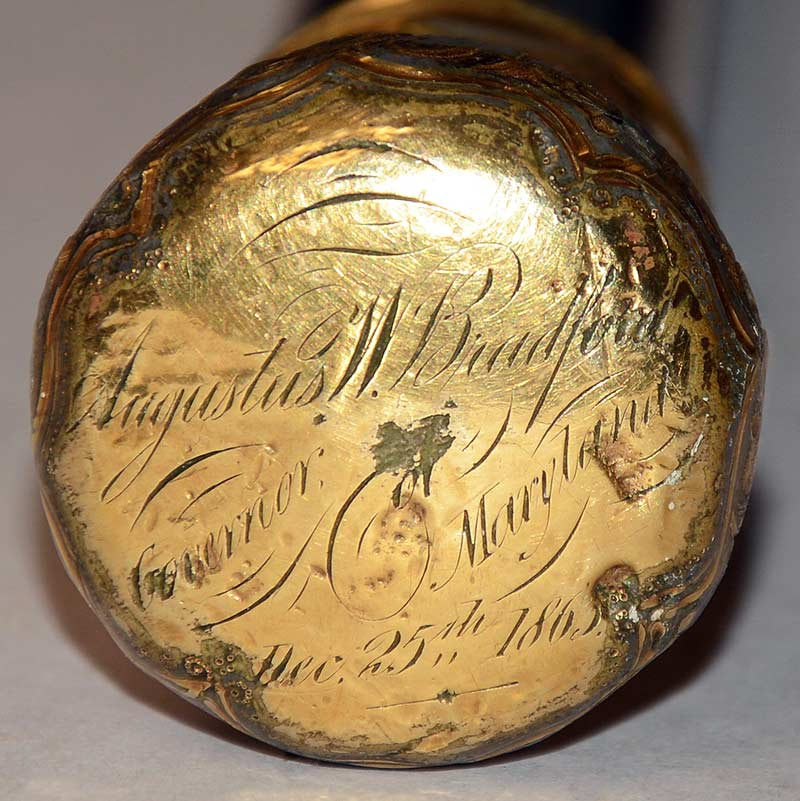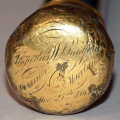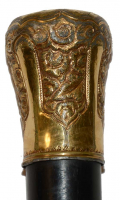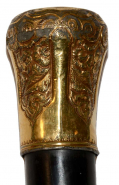site search
online catalog
1863 DATED WALKING STICK IDENTIFIED TO MARYLAND GOVERNOR AUGUSTUS W. BRADFORD

$2,500.00 SOLD
Quantity Available: None
Item Code: 766-1824
Attractive wooden walking stick we believe to be made of ebony, with a gold knob at top. The walking stick meas. approx. 33.50 inches long. The bottom end is missing the finial but the top has a very ornate gold knob. The sides and top of the knob are engraved with a scrollwork and floral design while the face is finely engraved with “Augustus W. Bradford / Governor of Maryland / Dec 25th 1863.” The body of the walking stick shows scattered light wear; the gold knob has some wear and nicks, but the inscription is clearly legible.
Below is an abbreviated version of a more full biographical report, including newspaper clippings, etc. which can be read by clicking here.
A descendant of William Bradford, who was a captain in the Harford Company of Minute Men and a signer of the Harford Declaration in 1775, Augustus Bradford served as governor of Maryland from 8 January 1862 to 10 January 1866. Among his many gubernatorial acts was annually announcing the date of a day of thanksgiving (or as we know it now, Thanksgiving).
In November in 1863 saw Bradford in Gettysburg at the delivery of what has gone down in history as the Gettysburg Address. At the same event he witnessed the consecration of the Gettysburg cemetery for the Union dead, the acquisition and establishment of which he had played a key role.
Bradford’s other acts while in office included freeing Samuel Green, an emancipated black man who had been sentenced in 1857 to a term of ten years for possessing a copy of “Uncle Tom’s Cabin.”
In July 1864, during one of three Rebel incursions into Maryland, Bradley T. Johnson’s raiders burned Bradford's home to the ground. Bradford was not at the residence at the time, and it is reported that he sent word for his family to depart it ahead of time. It is also reported that the conflagration took all of his furnishings, papers, and other possessions with it, but that does not seem to be factual. Witness the survival of the cane (although he could have been carrying it) as well as numerous documents and other family possessions. Careful perusal of the newspapers of the time suggest that Bradford had not one but two residences, which could account for the survival of possessions known to predate the burning of a Bradford residence.
In any event, the burning is said to have been done in retaliation for Gen. David Hunter’s burning of the residence of Virginia’s Gov. John Letcher. It was also intended as a fiery statement about Bradford’s staunchly unionist beliefs.
Bradford died in 1881, and his wife passed away in 1895.
Son Kell Bradford, trustee of Augustus Bradford’s estate, had already sold some of the family’s real estate by then, and other possessions apparently traveled down through some of the surviving family’s hands. Unfortunately, the will of Augustus Bradford did lead to some disputes among the descendants that continued through the early 1900s.
It is known that at least some of Gov. Bradford’s personal family property made its way down the Samuel Bradford line (another of Augustus’ sons) to direct descendant Eleanor (Bradford) Syckes, for she is credited for it now residing in the holdings of the Maryland State Archives.
Indeed, Augustus’s son Samuel Bradford outlived all of the many children of Augustus with the exception of a sister who was an unwed woman in a holy order out west. Thus the silver passing down that line seems reasonable.
The cane surfaced with an ownership attribution to the estate of Georgia (Langenfelder) Linthicum, who died in Maryland in 2009, and no familial relationship or an intersection between her lines and those of the Bradfords has yet been found. Georgia Linthicum was, however, involved with historical interests, and her “in lieu of flowers” request in her death notice states that donations could be made to the Star Spangled Banner House in Baltimore. In addition, her former spouse, Lt. Col. George E. Linthicum III (ret.) was a director of the Maryland Historical Society, so a more than reasonable assumption about historical interests can be made there as well. Essentially, acquisition of a Maryland-related historical object is quite explicable, although the precise line of provenance is currently unknown. [nr/ld] [ph:L]
~~~~~~~~~~~~~~~~~~~~~~~~~~~~~~~~~~~
THIS ITEM, AS WITH ALL OTHER ITEMS AVAILABLE ON OUR WEB SITE,
MAY BE PURCHASED THROUGH OUR LAYAWAY PROGRAM.
CLICK HERE FOR OUR POLICIES AND TERMS.
THANK YOU!
Inquire About 1863 DATED WALKING STICK IDENTIFIED TO MARYLAND GOVERNOR AUGUSTUS W. BRADFORD
For inquiries, please email us at [email protected]
Most Popular
Historical Firearms Stolen From The National Civil War Museum In Harrisburg, Pa »
Theft From Gravesite Of Gen. John Reynolds »
Selection Of Unframed Prints By Don Troiani »
Fine Condition Brass Infantry Bugle Insignia »
British Imported, Confederate Used Bayonet »
Scarce New Model 1865 Sharps Still In Percussion Near Factory New »
featured item
DAGUERROTYPE IN UNIFORM OF LEWIS HENRY LITTLE, BREVET FOR GALLANT AND MERITORIOUS CONDUCT AT MONTEREY 1846; KILLED IN ACTION AS CONFEDERATE BRIGADIER GENERAL AND DIVISION COMMANDER AT IUKA 1862
This very clear sixth-plate daguerreotype dates about 1850 and shows Lewis Henry Little, usually referred to by his middle name, as a Captain in the 7th U.S. Infantry. Born in Maryland in 1817, he was appointed 2nd Lieutenant in the 5th US Infantry… (1138-1808). Learn More »
site search
Upcoming Events
May 16 - 18: N-SSA Spring Nationals, Fort Shenandoah, Winchester, VA Learn More »










